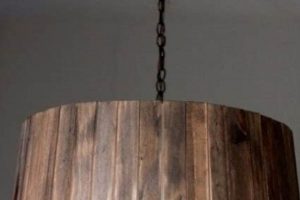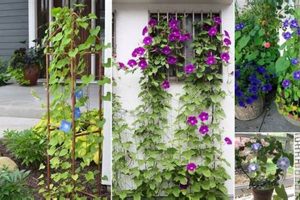The concept revolves around methods of preserving floral tributes received during a funeral service and transforming them into enduring mementos through do-it-yourself projects. An example would be pressing petals to create bookmarks or using resin to encapsulate entire blooms within decorative objects.
This practice offers several benefits, serving as a tangible connection to the deceased and providing comfort during the grieving process. Historically, preserving flowers as a symbol of remembrance dates back centuries, evolving from simple pressing techniques to more sophisticated methods.
The ensuing discussion will delve into specific techniques for preserving funeral flowers, outlining a variety of achievable do-it-yourself keepsake projects suitable for different skill levels and preferences.
Preservation and Crafting Tips for Memorial Floral Tributes
The following guidelines offer practical advice for transforming funeral flowers into lasting reminders, ensuring respectful handling and optimal preservation results.
Tip 1: Commence Promptly: Initiate the preservation process as soon as feasible following the funeral service. Fresh flowers yield better results than those that have begun to wilt or decay.
Tip 2: Segregate Blooms Carefully: Separate individual flowers or petals before commencing preservation. This allows for even drying or encapsulation, preventing mold or uneven results.
Tip 3: Implement Appropriate Drying Methods: Select a drying method suitable for the specific flower type. Air drying, pressing, or using desiccants like silica gel are common options; each offers varying degrees of preservation quality.
Tip 4: Employ Resin with Caution: When using resin for encapsulation, work in a well-ventilated area and adhere strictly to the manufacturer’s instructions. Improper mixing or curing can lead to clouding or structural weakness.
Tip 5: Safeguard Preserved Items: Store finished keepsakes away from direct sunlight and excessive moisture to prevent fading or degradation over time. Consider using archival-quality materials for framing or display.
Tip 6: Consider Bloom Suitability: Some flowers preserve better than others. Roses, carnations, and chrysanthemums tend to be more amenable to preservation than delicate blooms like lilies or orchids.
Tip 7: Document the Process: Maintain a record of the flowers’ origin (e.g., “from Grandfather’s casket spray”) to imbue the finished keepsake with deeper personal significance.
Tip 8: Test a Single Bloom: Before committing to preserving the entire bouquet, test the chosen method with a single bloom. This allows for adjustments to technique or selection of alternative preservation methods.
Adhering to these recommendations will contribute to the successful creation of meaningful keepsakes, providing enduring reminders of the deceased and the sentiments expressed through floral tributes.
The following section explores specific keepsake project ideas, offering step-by-step guidance for creating personalized memorial items.
1. Preservation Techniques
Effective preservation is paramount to transforming funeral flowers into lasting keepsakes. The chosen technique directly influences the visual appeal, structural integrity, and longevity of the resulting memorial item.
- Air Drying
Air drying involves hanging flowers upside down in a cool, dark, and dry environment. This method is suitable for robust flowers like roses and hydrangeas. The resulting keepsake will have a natural, slightly shrunken appearance. Improper ventilation can lead to mold growth, compromising the floral material and the intended keepsake.
- Pressing
Pressing flowers flattens and dries them between absorbent materials such as paper or cloth. This technique is ideal for creating keepsakes like framed art or bookmarks. The pressed flowers retain their color but lose their three-dimensional form. Insufficient pressure or moisture absorption results in incomplete drying and potential decay.
- Desiccant Drying
Desiccants, such as silica gel, absorb moisture from flowers, preserving their shape and color more effectively than air drying. This method is suitable for delicate flowers that may be damaged by pressing. The desiccant must be completely dry to prevent mold. Over-drying can cause brittleness and shattering.
- Resin Encapsulation
Encapsulating flowers in resin protects them from environmental damage and creates a transparent, durable keepsake. This technique is suitable for creating jewelry, paperweights, or other decorative items. The resin must be properly mixed and cured to prevent cloudiness or yellowing. Flowers must be thoroughly dried before encapsulation to prevent moisture-related issues.
Each preservation technique offers distinct advantages and limitations for do-it-yourself funeral flower keepsakes. The choice depends on the type of flower, the desired aesthetic, and the intended use of the final product. Selecting an appropriate method and executing it correctly are essential for creating a meaningful and lasting memorial.
2. Craft Project Selection
The selection of an appropriate craft project is integral to successfully realizing do-it-yourself funeral flower keepsakes. The inherent fragility of preserved floral material necessitates careful consideration of the project’s complexity, intended use, and aesthetic compatibility. For instance, delicate pressed petals may be ill-suited for incorporation into a heavily handled item like a keychain but are well-matched to a framed piece of art, where they are protected from physical stress. Improper craft project selection can lead to damage or degradation of the preserved flowers, undermining the memorial’s intended purpose.
Furthermore, the selected project should align with the individual’s skill level and available resources. Attempting a complex resin casting project without prior experience can result in unsatisfactory results and wasted materials. Simpler alternatives, such as creating laminated bookmarks or potpourri sachets, offer a lower barrier to entry while still providing a meaningful outlet for remembrance. The choice of materials used in conjunction with the preserved flowers is also crucial. Acid-free paper, UV-resistant sprays, and archival-quality adhesives contribute to the keepsake’s longevity, preventing discoloration and deterioration over time.
Ultimately, informed craft project selection represents a critical step in the do-it-yourself funeral flower keepsake process. It requires balancing aesthetic preferences with practical considerations, ensuring that the chosen project effectively showcases and preserves the flor
al tributes while providing a lasting and meaningful memorial. Neglecting this step can diminish the project’s impact and longevity, thus reducing its effectiveness as a source of comfort and remembrance.
3. Material Considerations
Material selection exerts a direct influence on the quality and longevity of funeral flower keepsakes crafted via do-it-yourself methods. The chemical composition and physical properties of each material, from desiccants used in flower preservation to adhesives used in assembly, determine the final product’s resistance to environmental degradation and physical stress. For instance, using non-archival quality paper as a backing for pressed flowers will, over time, lead to acid migration and discoloration, diminishing the keepsake’s visual appeal and structural integrity. Conversely, selecting acid-free paper mitigates this risk, ensuring prolonged preservation of the floral components.
Furthermore, material choices impact the aesthetic characteristics of the keepsake. The selection of resin for encapsulation, for example, determines the clarity and light transmission properties of the final product. Low-quality resins may exhibit clouding or yellowing, obscuring the preserved flowers and detracting from their inherent beauty. Similarly, the type of frame chosen for a pressed flower arrangement influences the perceived value and presentation of the keepsake. A cheap plastic frame can undermine the emotional significance of the memorial, while a thoughtfully selected wooden or metal frame can enhance its aesthetic appeal and perceived permanence.
In conclusion, material considerations are not merely cosmetic choices within do-it-yourself funeral flower keepsake projects; they are fundamental determinants of the keepsake’s enduring quality and symbolic value. Informed selection of preservation agents, adhesives, mounting materials, and display components is essential for creating meaningful and lasting memorials that effectively honor the deceased and provide comfort to the bereaved. Overlooking these material considerations can result in premature degradation and a diminished emotional impact, negating the intended purpose of the keepsake.
4. Personalization Options
Personalization options represent a critical element in the creation of do-it-yourself funeral flower keepsakes. These modifications transform generic mementos into deeply personal tributes, reflecting the unique relationship between the deceased and the bereaved. The incorporation of personalized details directly influences the emotional resonance and enduring significance of the keepsake. For instance, embedding a small, engraved plate bearing the deceased’s initials and dates within a resin-encased flower arrangement adds a layer of personal connection absent from a purely floral display. Without such personalization, the keepsake risks becoming a generic item, devoid of the specific memories and emotions it is intended to evoke. Therefore, personalization options are not merely decorative additions; they are integral to the function and purpose of these keepsakes.
Practical applications of personalization options extend beyond simple inscriptions. The integration of items personally belonging to the deceased, such as a small photograph or a piece of fabric, into the keepsake further enhances its sentimental value. For example, incorporating a pressed flower from the funeral arrangement alongside a swatch of the deceased’s favorite shirt within a shadow box creates a multi-sensory memorial. Similarly, digitizing the flower images and combining them with audio recordings of eulogies or favorite songs into a personalized digital photo frame exemplifies a modern approach to personalization. These multifaceted strategies demonstrate the potential for personalization options to transform a simple floral memento into a complex and deeply moving tribute. The absence of thoughtful personalization reduces the keepsake to a mere object, failing to capture the essence of the relationship and the depth of the grief.
In summary, personalization options are essential to the efficacy of do-it-yourself funeral flower keepsakes. They provide the means to transform generic floral tributes into tangible embodiments of individual relationships and cherished memories. Challenges in implementing personalization options may include sourcing suitable materials or overcoming technical hurdles in digital integrations. However, the resulting increase in the keepsake’s emotional significance far outweighs these challenges. By focusing on thoughtful and meaningful personalization, these projects become more than just crafts; they become enduring expressions of love and remembrance, offering comfort and solace in the grieving process.
5. Storage Longevity
The success of “funeral flower keepsake ideas diy” projects hinges significantly on storage longevity. Improper storage can negate the efforts expended in preservation and crafting, leading to deterioration and loss of the memorial’s intended impact. For example, a pressed flower arrangement, meticulously crafted, will quickly fade and degrade if exposed to direct sunlight or high humidity. The preservation techniques employed initially (air drying, pressing, silica gel drying, resin encapsulation) establish a baseline level of protection, but the subsequent storage environment dictates the keepsake’s ultimate lifespan.
The impact of storage conditions on longevity manifests in several ways. Exposure to ultraviolet (UV) radiation causes color fading in both the preserved floral material and any associated paper or fabric elements. High humidity promotes mold growth, leading to irreversible damage and potential health risks. Fluctuations in temperature can cause expansion and contraction of materials, resulting in cracking or delamination. Therefore, optimal storage involves minimizing exposure to light, humidity, and temperature variations. A practical approach includes storing keepsakes in acid-free boxes or display cases, placing them away from direct sunlight or heat sources, and maintaining a stable, moderate temperature and humidity level. UV-protective glass in display cases and desiccants within enclosed storage spaces offer additional protection.
In conclusion, achieving storage longevity is paramount to the enduring success of “funeral flower keepsake ideas diy” initiatives. It is not merely an afterthought but an integral component of the entire process, requiring proactive measures to mitigate environmental risks. While preservation and crafting techniques establish the keepsake’s initial state, appropriate storage ensures its long-term viability as a meaningful and lasting memorial. Ignoring this aspect will inevitably result in the premature degradation and loss of these irreplaceable tributes.
Frequently Asked Questions
The following addresses common inquiries regarding the creation of lasting memorials from funeral flowers through do-it-yourself projects.
Question 1: What is the optimal timeframe for commencing the preservation process of funeral flowers?
The preservation process should ideally begin within 24 to 48 hours of receiving the flowers. Fresh flowers yield significantly better
results compared to those that have begun to wilt or decay.
Question 2: Is it possible to preserve all types of funeral flowers using the same method?
No, different flower types require different preservation methods. Delicate blooms are best preserved using desiccants like silica gel, while sturdier flowers may be air-dried or pressed. Selecting the appropriate method is crucial for optimal preservation.
Question 3: What precautions should be taken when using resin for encapsulating funeral flowers?
Resin encapsulation should be performed in a well-ventilated area, adhering strictly to the manufacturer’s instructions. Proper mixing ratios and curing times are essential to prevent clouding, yellowing, or incomplete hardening of the resin.
Question 4: How can discoloration of pressed funeral flowers be prevented?
Discoloration can be minimized by using acid-free paper for pressing, avoiding direct sunlight exposure, and applying a UV-protective spray to the finished keepsake.
Question 5: What are the key considerations for long-term storage of funeral flower keepsakes?
Keepsakes should be stored in a cool, dry place away from direct sunlight and temperature fluctuations. Acid-free storage boxes and UV-protective display cases can further extend the keepsake’s lifespan.
Question 6: How can mold growth be prevented during the air-drying process?
Proper ventilation is essential to prevent mold growth. Ensure adequate air circulation around the flowers and maintain a low humidity environment. Adding a desiccant to the drying area can also help reduce moisture levels.
Successful do-it-yourself funeral flower keepsakes necessitate timely action, appropriate preservation techniques, careful material selection, and proper storage to ensure lasting quality.
The subsequent article segment explores advanced keepsake creation strategies for seasoned crafters.
Conclusion
The preceding discussion has explored various facets of “funeral flower keepsake ideas diy,” encompassing preservation methodologies, craft project selection, material considerations, personalization options, and storage longevity. Successful execution of these elements is paramount in transforming ephemeral floral tributes into enduring memorials.
The creation of these keepsakes provides a tangible connection to departed loved ones, offering solace through the act of remembrance. By diligently applying the principles outlined, individuals can create meaningful tributes that withstand the test of time, serving as lasting symbols of affection and remembrance.




![Creative DIY Mobile Home Skirting Ideas [Guide] The DIY Hub: Creative Crafts, Repairs & Life Hacks Creative DIY Mobile Home Skirting Ideas [Guide] | The DIY Hub: Creative Crafts, Repairs & Life Hacks](https://craftingdiycenter.com/wp-content/uploads/2025/07/th-4605-300x200.jpg)


